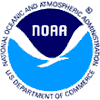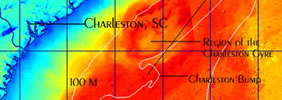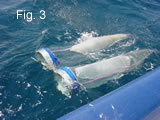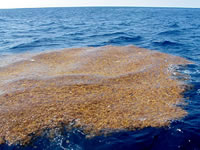| Charleston
Gyre |

 |
 |
 |
| Posted February 4th, 2003 | ||||||||||||||||||||
| Ms.
Justice's class at St. Egbert's school in Morehead City, NC. asks: Q: What is the temp difference (at the same depth ) in the gulf Stream as compared to other ocean water? A: Looking at sea surface temp from Feb. 3, at Atlantic Beach it would be about 48 degrees. the warmest water of the Gulf Stream is about 75 degrees. the temp of water near shore would be uniform due to the mixing from wind and tide. I'll give you the values at depth from one of our CTD casts in the Stream so you can plot them out.
|
||||||||||||||||||||
| Ms.
Justice's class at St. Egbert's school in Morehead City, NC. asks: Q: How do you pronounce the word gyre? Is it like guy-ree? A: Pronounce it like tire but with a J sound at the beginning. |
||||||||||||||||||||
| Posted February 5th, 2003 | ||||||||||||||||||||
| Ms.
Justice's class at St. Egbert's school in Morehead City, NC. asks: Q: How does the “bump” affect living things in the ocean?  A: The short answer is that there is more primary production
(production at the lowest links in the food web) in the eddy formed by
the “bump” than the
surrounding continental shelf water. That increase in production is believed
to trickle up the food web to higher- level organisms. The other consideration
is that the eddies that spin off may transport fish, crabs, and shrimp
that spawn offshore to nursery areas. There are most likely many other
relationships as well. The American Fisheries Society dedicated an entire
symposium to the studies of the “ bump.”
A: The short answer is that there is more primary production
(production at the lowest links in the food web) in the eddy formed by
the “bump” than the
surrounding continental shelf water. That increase in production is believed
to trickle up the food web to higher- level organisms. The other consideration
is that the eddies that spin off may transport fish, crabs, and shrimp
that spawn offshore to nursery areas. There are most likely many other
relationships as well. The American Fisheries Society dedicated an entire
symposium to the studies of the “ bump.” |
||||||||||||||||||||
| Ms.
Justice's class at St. Egbert's school in Morehead City, NC. asks: Q: Are you tagging any fish? A: No. We are mainly catching larval fish and small adult fishes with the mesh we are using (505 micron openings). Tagging fish of that size would probably be lethal even though tags have become very small (coded wire). The mortality is extremely high during the egg and larval stages. The likelihood of ever getting a tag return would be infinitely small |
||||||||||||||||||||
| Ms.
Justice's class at St. Egbert's school in Morehead City, NC. asks: Q: What does a bongo net look like? Is it similar to a shrimp net? A:
The only similarity to a shrimp net is the knot keeping the back of
the net c |
||||||||||||||||||||
| Ms.
Justice's class at St. Egbert's school in Morehead City, NC. asks: Q: We read on the home page that this is the fourth time this research has been done. Are there plans to go back again? A: The work has been proposed and the ship time scheduled. The work last year was a little different. For instance we used bongo nets and no MOCNESS and we didn’t deploy drifters. Last year we had about seven transects and tried to sample the entire Gyre. This year we are tracking bodies of water and sampling smaller areas more intensively. This type of work always changes depending on the hypothesis we are testing
|
||||||||||||||||||||
| Ms.
Justice's class at St. Egbert's school in Morehead City, NC. asks: Q: What do you do with the data you collect? A: The data will be evaluated in different ways. The physical data like temperature, salinity, and fluorometer values will be plotted using computer software. This will help us to visualize what is going on in the environment. The zooplankton samples collected from the 3 finer mesh nets will be sorted and identified by Marcy at the Beaufort Lab. The rest of the samples will be sent to Poland for sorting and identification. Then the biological and environmental data will be combined to give us a better understanding of how the Gyre affects production along our coastline. |
||||||||||||||||||||
| Posted February 6th, 2003 | ||||||||||||||||||||
| Ms.
Justice's class at St. Egbert's school in Morehead City, NC. asks: Q: Describe for us a day on board the ship. A:
(Answered by Rob Cheshire, Biological Science Technician) Today I woke
up about 10am. I intentionally slept through breakfast so that I don’t
feel guilty eating a sandwich at midnight. I laid around my cabin reading
for about an hour. The cabin is an 8’ x 10’ room with bunk
beds, a sink, and 2 dressers. My cabin mate, Mike Green, and I work
opposite shifts so I had the room to myself. I ate lunch at 11:30 and
took some pictures of the other shift putting the MOCNESS overboard.
I watched a Robert DeNiro movie and then it was 3:00, time to come on
watch. We started the watch with a CTD cast off the port bow down to
200m the bottom is 320 m but temperature and salinity don’t change
much once you get down that deep. Frank scooped up some surface water
with a bucket tied to rope. This water was filtered through fine filters.
They look like very thick coffee filters about the size of a half dollar.
The filters collect phytoplankton (microscopic plants) that contain
chlorophyll, a green pigment. We then freeze and will process them when
we return to determine the amount of chlorophyll in the water. This
is an indication of how much production there is at the bottom of the
food chain, primary production. Our first MOCNESS will not be until
8pm so we have some time to kill. Once we begin the sampling we will
be busy setting the net, preserving samples or making labels for the
sample jars until 3am. Shift over and bedtime. |
||||||||||||||||||||
| Kate
Schaefer of the South Carolina Phytoplankton Monitoring Network (SCPMN)
asks: Q: What are the optimal conditions for ichthyoplankton (i.e. temperature, salinity, etc.)? (Kate Schaefer, SCPMN) A: It depends on the species. Ichthyoplankton is found in all ocean waters. In cold arctic and antarctic waters you’ll find species such as arctic cod, ice fishes, and Chilean sea bass (aka: padagonian toothfish). In warm equatorial waters common species include parrotfish, wrasses, snapper and grouper. In the waters where we are sampling the most common species is menhaden. |
||||||||||||||||||||
| Ms.
Justice's class at St. Egbert's school in Morehead City, NC. asks: Q: Which way does the water spin in the eddy and why? A:
Looking down from the sky, the eddy we are tracking turns counter-clockwise.
This counter-clockwise rotation is caused by the location of the eddy
in a trough of a Gulf Stream meander. As the Gulf Stream flows northward
it meanders, much like a rope held tight at one end and whipped at the
other. Where the Gulf Stream path is closest to the shelf is called
a crest and where it is furthest away is called a trough. The eddy forms
in the trough. The meander crest in front of the eddy can interact with
the eddy and form a warm, southward flowing filament on the inshore
edge of the eddy. |
||||||||||||||||||||
| Ms.
Justice's class at St. Egbert's school in Morehead City, NC. asks: Q: Why did you decide to become a scientist? A: (Answered by Rob Cheshire, Biological Science Technician) Trial and error. I became interested in environmental issues and the ocean when I was living in Wilmington, NC. I decided to move to Chapel Hill, NC and take courses part time to see if I was interested in pursuing this route. I thumbed through an NC State catalogue one day and discovered they had a program in fisheries. I volunteered in a fisheries lab under the professor who eventually became my graduate school advisor. I worked as a technician polishing fish ear stones (otoliths) for 4 years while I completed my bachelors degree. Before I became a scientist I was a photofinisher, a waiter and a bartender. My career advice to anyone would be to start early to get our foot in the door to see what someone in that career actually does. Even now you could ask to tag along with someone for a couple of days to work (during the summer). |
||||||||||||||||||||
| Sue
Morrison, Marine Science Teacher from James Island, SC. asks: Q: Do you see much Sargassum weed in the area of the Charleston Gyre? If so, have you noticed any differences in ichthyoplankton around it? A:
Yes, we see quite a bit of Sargassum weed. It is especially abundant
right at the boundary of the Gulf Stream. This is due to the downwelling
that occurs there. Most nutrients and plankton are carried downward
at this |
||||||||||||||||||||
| Ph.
843-953-7263 |
Project
Oceanica Dept. of Geology & Environmental Geosciences College of Charleston Charleston, SC 29424 |
Fax
843-953-7850 |
 losed.
The frame looks like the top of a big bongo drum with 1 meter diameter
openings.
A net is attached to each of the openings. The mesh size is a little
smaller than the MOCNESS (333 micron).
We lower it to the bottom and pull it up while the ship
is slowly moving forward. This is called an oblique tow because the
angle of the transect it makes is oblique to the bottom.
losed.
The frame looks like the top of a big bongo drum with 1 meter diameter
openings.
A net is attached to each of the openings. The mesh size is a little
smaller than the MOCNESS (333 micron).
We lower it to the bottom and pull it up while the ship
is slowly moving forward. This is called an oblique tow because the
angle of the transect it makes is oblique to the bottom. boundary
but the Sargassum weed remains at the surface due to its numerous “bladders”
which keep it afloat. Sargassum weed has very distinct groups of fishes
associated with it. It is a very important habitat for a number of juvenile
fishes. Some of the ichthyoplankton species associated with Sargassum
weed are jacks, filefish and red porgy. We haven’t caught any
Sargassum weed because it is very patchily distributed in the area where
we’ve been sampling.
boundary
but the Sargassum weed remains at the surface due to its numerous “bladders”
which keep it afloat. Sargassum weed has very distinct groups of fishes
associated with it. It is a very important habitat for a number of juvenile
fishes. Some of the ichthyoplankton species associated with Sargassum
weed are jacks, filefish and red porgy. We haven’t caught any
Sargassum weed because it is very patchily distributed in the area where
we’ve been sampling.